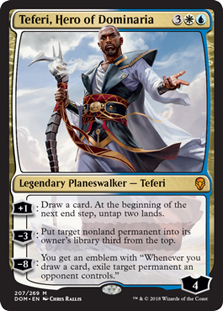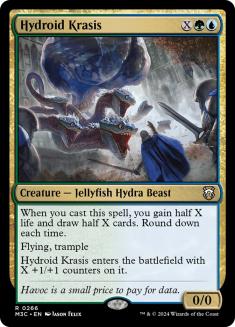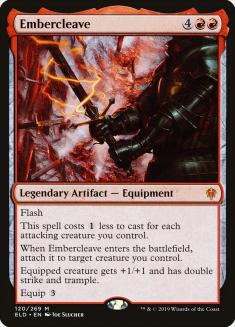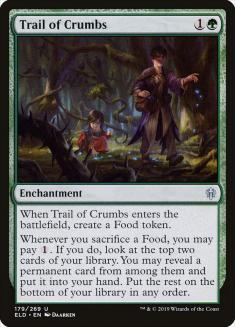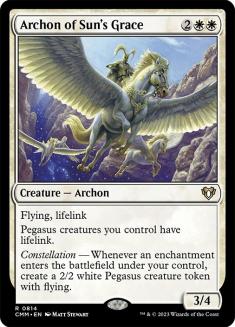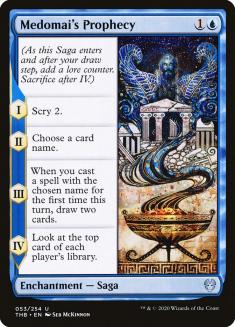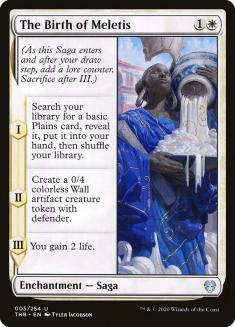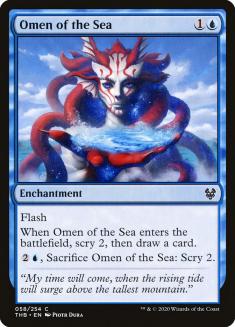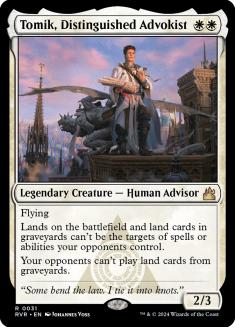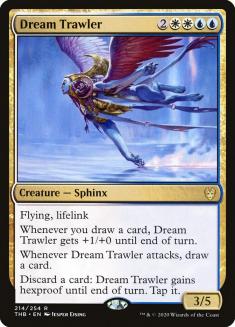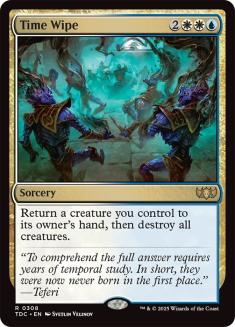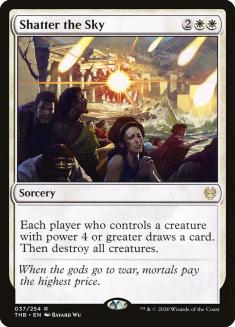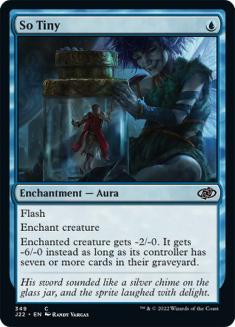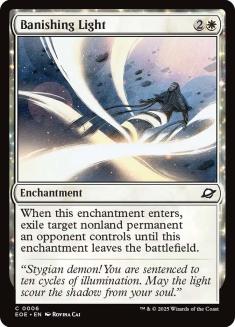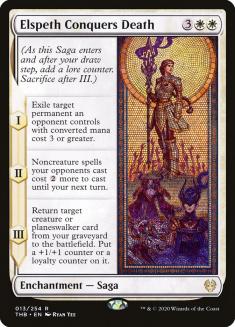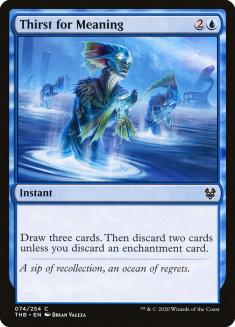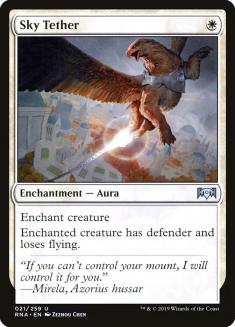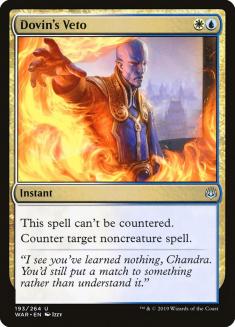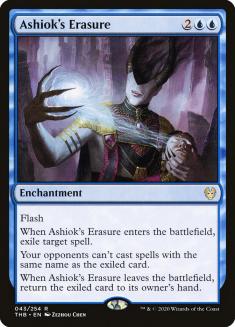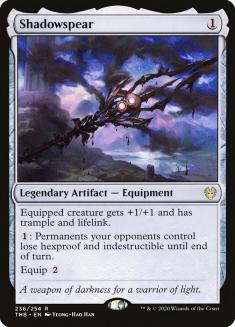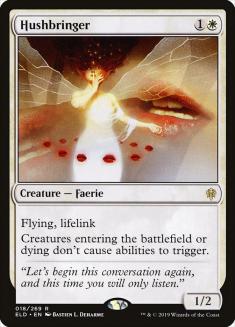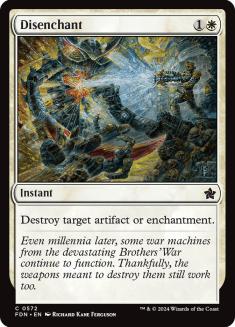Some thoughts on the period immediately after the release of a new set:
It seems like the Magic community has started taking the wrong approach to Week 1 formats. I’ve shared a bunch of decklists over on my Twitter feed over the last week or so, and it seems people are shocked when something I’ve put forth has a particularly bad matchup or is inconsistent in its ability to achieve its end-game.
Week 1 is about identifying potential. The refinement that is required to catapult a deck to Tier 1 is rarely going to come from a single person. Dozens of configurations must be tested, new cards must be cast to be understood, and all of this is being done (at least this go-around) in the absence of any immediate tournament results that could start to define a meta.
It may be a consequence of Arena laddering that people now place an immediate onus on achievement that just doesn’t particularly jell with the game of Magic. Consider the adage of “Play aggro Week 1.” It isn’t that people don’t prepare for aggro decks; it’s just way harder for an aggro deck to be completely non-functional. When there is a legitimately good control or midrange deck, I’d almost always rather be playing that early in a format. The tools to punish these decks are usually more specific than those that can punish aggro.
This isn’t to say building the best aggro deck is easier or playing an aggro style is easier. These too are myths that should be put to rest. It’s just that the delta between the quality of an optimal aggro deck and its flawed first draft is smaller than the delta between the bad version of a control or engine deck and its final form. Playing over-buffed creatures and other damage-dealing threats can only go so wrong, especially when you consider the capacity for opposing flood or screw.
I want to continue to share promising ideas that need refinement, but the Magic community needs to adjust back to a place where sharing sketches is acceptable. For my part, I need to do a better job making clear when I see a deck as ready for competition. So, here we go:
Play this deck if you want to win in Theros Beyond Death Standard.
Creatures (6)
Planeswalkers (4)
Lands (26)
Spells (24)

Theros Beyond Death delivered the absolute goods when it comes to white cards, and not only in the aggressive decks. I’ve seen Azorius decks operating across the entire spectrum from aggro to control.
For those of you who have followed my content for some time, it probably comes as a shock to see me position myself squarely in the middle of the spectrum. I’ve long viewed winning games as a mere inconvenience when I build decks. As one of the first proponents of the win-conditionless Teferi, Hero of Dominaria decks (sorry about that), I’ve got a well-earned reputation for allowing games to stretch on into infinity.
In Theros Beyond Death Standard, I believe there are multiple card packages that incentivize control decks to end the game. The card advantage suite of Mono-Black Devotion and its four Castle Locthwain has the capability to punish games that don’t end. Similarly, Bolas’s Citadel only needs a turn on the battlefield to push the game completely out of reach.
If you’re ever caught without countermagic on a key turn, it’s trivial for them to snowball a game that you’ve controlled 95% of the time. Add in the fact that they will have access to discard and sacrifice effects in sideboard games, and I’m just not convinced I routinely want the game to go twenty turns while banking on a solitary threat. Against poorly built versions of Mono-Black Devotion, I buy the pure control plan as enough to get by. As the lists become refined, I’m less convinced.
Similarly, Simic decks contain the Hydroid Krasis “Get Out of Jail Free” card. They can always count on that burst of card advantage as the game goes long. Alongside this strength comes a very real weakness, as they simply don’t do a great job containing a creature that can go wide all by itself.
Even Rakdos Knights is surprisingly adept at navigating long games thanks to their combination of Castle Locthwain, Stormfist Crusader, and the burst damage of an Embercleave carried by a Rotting Regisaur or Knight of the Ebon Legion.
Food decks have Trail of Crumbs, all the sacrifice decks have Witch’s Oven and Cauldron Familiar, and even Mono-White Aggro has the impossibly sticky Elspeth, Sun’s Nemesis. Every deck has powerful tools to play long games, and asking your deck to account for them all before the metagame has solidified is a fool’s errand.
Someone recently told me they believe lifelink to be the most underrated keyword in Magic, and I completely agree. Having a primary win condition with lifelink shuts down many potential outs for opponents and weakens one of the primary weapons in the expert player’s arsenal: their ability to dictate an opponent’s actions via pressure. Archon of Sun’s Grace offers up that stability at a spot on the curve that gives it value as a pure defensive tool, while still providing the late-game snowball that has become the hallmark of almost every other successful Standard deck over the past year. Once I realized I wanted my Azorius deck to be focused on Archon of Sun’s Grace, the rest of the pieces mostly fell into place. Let’s look at the packages contained here in greater detail.
The glue that holds our deck together. Each of these cards is so quietly powerful in a deck that maximizes their synergies. In the early-game, we never want to miss a land drop. With eight two-mana enchantments in our deck, our range of keepable hands goes up dramatically, as any two-lander with one of these enchantments is likely to be a keep. The Birth of Meletis is a bunch of text that all adds up to a bad time for aggro opponents, and the 0/4’s ability to protect our planeswalkers from Nissa, Who Shakes the World ambushes comes up constantly.
One of the biggest points of controversy across Azorius archetypes is Medomai’s Prophecy versus Omen of the Sea. The starting point for this argument is simple to me. Omen of the Sea provides an effect with many analogs. Two-mana cantrips are historically fine and have seen play when their unique aspects line up with a deck’s strategic needs (see Discovery for an example).
Two-mana draw-twos, on the other hand, are exceedingly rare, to the extent that something like Night’s Whisper sees occasional Legacy and Modern play. There is no question that Medomai’s Prophecy sets forth a huge number of hoops to jump through, but the sheer card quantity is hard to deny. I have rarely missed drawing two cards from Prophecy. The greater problem is just how slow those cards are to arrive. In situations where you have an Archon of Sun’s Grace on the battlefield and plenty of available mana, it’s easy to turn Omen of the Sea into a second trigger immediately. Keep in mind that you can respond to Omen’s draw trigger with the scry ability when you are looking for an answer in short order. Unlocking instant-speed Pegasuses is also a big get when you choose Omen of the Sea.
Overall, Medomai’s Prophecy offers greater upside, but the decision remains close. I think a split is acceptable and 3/1 in favor of Prophecy has been great for me. All three of these enchantments are truly taken to the next level by an old friend.
Spending words writing about how good Teferi, Time Raveler is seems silly at this stage in its existence, but this deck might maximize Teferi’s bounce ability better than any deck to come before it. The raw card advantage you can squeeze out of a bounced Medomai’s Prophecy is a fine starting point, but there are so many other tricks up Teferi’s sleeve here. Additional Pegasuses, rebuying an Elspeth Conquers Death to deal with another huge threat, and even picking up a Banishing Light and freeing a creature because you know you’re about to cast a sweeper are all on the table here. We are not as well set up to take advantage of the Quicken ability with only five sorceries in the entire 75, but the best effect to speed up with Teferi has always been a sweeper and we’ve got five of those.
Teferi also remains a key part of our plan against opposing Azorius Control decks. I perceive pure control as weaker against the field but stronger against us due to our tap-out style.
Certainly, the most out-of-place card in this entire list is Tomik, Distinguished Advokist, but I think I can make a good case for it. In Game 1 against Simic Ramp lists, there’s a very good chance they are unable to remove a Tomik. Shutting down their most powerful threat (Nissa) at the cost of only two mana is a huge return on investment and scrying so often while drawing a large number of cards gives a lot of control over your draw step.
I really wanted one more potential target for Elspeth Conquers Death and wanted it to be a card with some defensive capabilities that could show up early. Tomik was the most impactful creature I found. The 2/3 body looks good against many of the Knights and blocks nearly everything from the Mono-Black Devotion decks. Flying even helps pressure opposing Teferis regardless of the appearance of 0/4 Walls. I’d hear cases for other two-drop creatures for sure, but Tomik has my vote presently.
And now, Dream Trawler. Oh boy. What an incredible combination of abilities on a creature. Hexproof Baneslayer Angel with a personal Howling Mine strapped on isn’t all that far off. I do expect decks to make appropriate concessions to this card, and when that happens, expect its metagame share to drop drastically. A six-mana creature with no immediate impact can only shine when it’s not being properly accounted for in deckbuilding. While hexproof on demand makes answering Dream Trawler challenging, there are some options. I’m seeing more and more sacrifice effects making their way into lists. One of my favorites is Consecrate // Consume. Versatile cards like Shadowspear will deservedly get a look as well. Until that time, slam Dream Trawler and enjoy your free wins.
Our anti-creature package. If the Azorius color combination has a pronounced weakness, it’s a lack of early removal. So Tiny is a barely acceptable Magic card, but it does scale well as the game goes on and flash enchantments in combination with Archon add some trickiness to your play. I started with a greater number of Time Wipes in my deck, but Time Wipe is simply non-functional against aggro on the draw. While the bounce effect is occasionally nice, your creatures are so powerful that if they go unanswered, they’re probably controlling aggression singlehandedly.
The fact that our catch-all, exiling removal spell also comes with a buffed reanimation effect stapled to it is exactly what enables this archetype to work. I underestimated Elspeth Conquers Death due to what I saw as a mediocre second chapter. Honestly, though, who cares about the second chapter when the first and third are just game-breaking? If only there was some way we could reliably fuel our graveyard to ensure we always find a strong reanimation target…
For someone who’s been around the game for as long as I have, it’s hard to believe this is a real card. Thirst for Knowledge was restricted in Vintage for years, and while draw spells have increased in power recently, three cards deep for three mana is still the real deal. The fact that it plays so well with Elspeth Conquers Death is just icing on the cake. I wouldn’t be at all surprised to learn I’m supposed to be playing four copies of this card, but I didn’t want to gum up my early action with multiple copies. The early-game is simply about survival and playing to the battlefield is far more important than generating card advantage. You’ve got so many ways to accumulate resources that if you survive, one will eventually come online.
A sideboard guide at this stage seems premature, but I can talk a bit about the cards I’ve included and where I see them being useful.
Our anti-aggro package does not have to be particularly large because our maindeck is set up so well against the archetype. I like Sky Tether as the sideboard option for as long as Rotting Regisaur remains around. The fact that it also slows down Embercleave is a slight upgrade as well. In Game 1, I’m okay with So Tiny being a higher-variance removal spell, since opposing aggro will not have shored up its ability to play around our sweepers. I also bring in the fourth Shatter the Sky against Mono-Black and Simic Ramp while cutting the So Tinys.
I started with a higher concentration of Dovin’s Veto, but if Teferi, Time Raveler remains a Magic card, it’s hard to talk yourself off Mystical Dispute. The presence of opposing Dream Trawlers also makes it tough to play without countermagic that can tag a creature. This can leave our countermagic in a weaker spot against things like Fires of Invention, but Ashiok’s Erasure alongside Banishing Light and Elspeth Conquers Death does a great job keeping their engine in check. This entire package comes in against opposing Azorius Control decks for the creature removal as you desperately try to secure the role of aggressor with the help of Elspeth, Sun’s Nemesis.
I’ve appreciated Elspeth against some aggro opponents, but I think the card is even stronger as your primary plan against control. The fact that you will always have access to an army in a can from your graveyard makes it challenging for control to close off all your roads to victory. If you can prevent them from just making the game about Dream Trawler, I like your chances.
Speaking of Dream Trawler, has it really come to this? I think the answer is actually yes. If Shadowspear is on the battlefield, it dramatically changes the texture of the game against any opposing deck that is looking to stick a Trawler. Add in a marginal buff when we’re highly incentivized to find a way to push through damage, and I’m onboard with Shadowspear.
Hushbringer has been incredible for me against Mono-Black Devotion and any deck that is relying on Thassa, Deep-Dwelling, of which there are several. While Hushbringer will die routinely, we have Elspeth Conquers Death for rebuys, and every removal spell spent on a Hushbringer brings us closer to an Archon of Sun’s Grace that survives.
Disenchant covers a lot of ground right now, but it’s important to only rely on it when it matters. Answering things like Nightmare Shepherd is not what we want to do with Disenchant. It is here for decks that are using Banishing Light as their primary form of removal and checking engines like Doom Foretold and Fires of Invention.
I can’t recommend this deck enough in the early days of Theros Beyond Death Standard. It asks opponents to account for many different gameplans while providing its pilot ample room for creative and inspired play. Furthermore, there are sideboard tools at the ready to account for just about any metagame shift.
Buy in early and start building mastery now.

